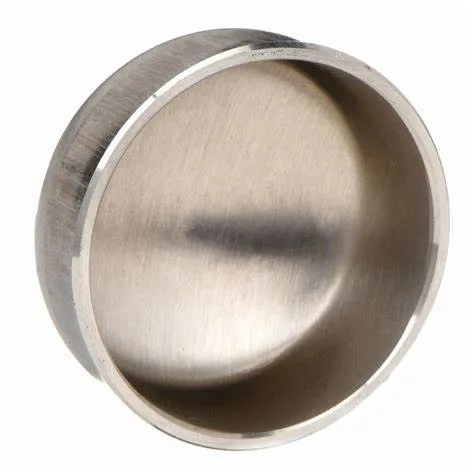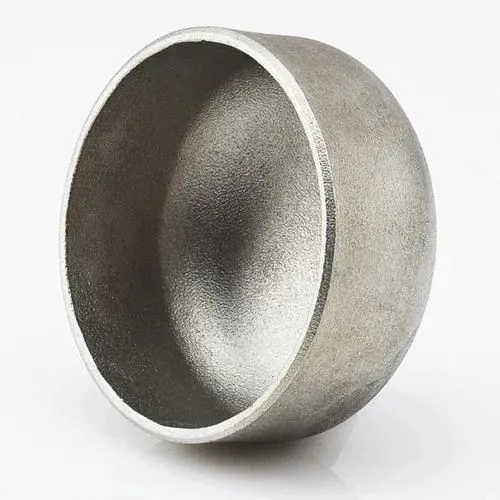JIS B2311 е јапонски индустриски стандард кој ги покрива приклучоците за цевки за заварување со задник, вклучително и капачиња што се користат во цевководните системи. Капаците за заварување со задник служат за затворање на крајот на цевката, обезбедувајќи заптивка за да се спречи истекување или контаминација. Еве еден вовед во JIS B2311 капачиња за заварување со задник:
- 1. JIS B2311 Standard:
- - Стандардот JIS B2311 ги специфицира барањата за дизајн, димензии, материјали, производство и тестирање на фитинзи за заварување со задник, вклучително и капачиња, во цевководните системи.
- - Стандардот гарантира дека капачињата произведени во согласност со стандардите JIS ги исполнуваат стандардите за квалитет и се компатибилни со другите компоненти на цевките.
- 2. Капа за заварување со задник:
- - Капачето за заварување со задник, според JIS B2311, е фитинг дизајниран за безбедно покривање и запечатување на крајот на цевката, нудејќи заштита и одржување на интегритетот на системот за цевки.
- - Капаците се користат во ситуации кога крајот на цевката бара затворање, трајно или привремено, за да се спречи истекување, контаминација или да се обезбеди завршница на системот.
- 3. Материјал и конструкција:
- - Капаците за заварување со задник според спецификациите JIS B2311 се достапни во различни материјали како јаглероден челик, нерѓосувачки челик и легиран челик за да се исполнат различните барања за примена.
- - Овие капачиња се произведени со стандардизирани методи на градба за да се обезбеди силна и без протекување врска кога се заваруваат до крајот на цевката.
- 4. Апликација и придобивки:
- - Капаците за заварување со задник се применуваат во различни индустрии, вклучително и нафта и гас, хемиски процеси, постројки за третман на вода и повеќе каде што завршетоците на цевките треба безбедно да се затворат.
- - Капаците обезбедуваат заштита на краевите на цевките од еколошките елементи, спречуваат контаминација и помагаат во одржувањето на чистотата и интегритетот на системот за цевки.
- 5. Инсталација и заварување:
- - Правилните практики на инсталација, вклучително правилно усогласување, подготовка на крајот на цевката и техники на заварување, се неопходни при инсталирање на капачиња за заварување со задник за да се обезбеди цврсто и отпорно на протекување.
- - Заварувањето е вообичаен метод за прицврстување на капачињата на цевките, обезбедувајќи сигурно и трајно затворање што може да издржи притисок, температурни варијации и проток на течност во системот.
- Накратко, JIS B2311 заварувачките капачиња се клучни компоненти што се користат во системите за цевки за безбедно запечатување и заштита на крајот на цевките. Овие капачиња се во согласност со стандардизираните барања за да се обезбеди квалитет, доверливост и компатибилност во индустриските апликации каде што е неопходно затворање и заштита на цевките.
What Is a Butt Welding Cap and How Is It Used in Industrial Piping?
In industrial piping systems, end-of-line sealing and branch closures require robust solutions. A butt welding cap serves as a critical component for terminating pipes securely. By providing a seamless, welded closure, this fitting maintains system integrity, prevents leaks, and supports compliance with industry standards.
What Is a Butt Welding Cap?
A butt welding cap—also called a pipe end cap or buttweld end cap—is a round fitting designed to close off the end of a pipe. It’s manufactured to match the pipe’s outer diameter and schedule, with either a hemispherical or flat face. To install, both the pipe end and cap are beveled to form a V‑groove, enabling full‑penetration, fusion welds. Common materials include carbon steel, stainless steel, nickel alloys, and other engineered grades, chosen to satisfy pressure, temperature, and corrosion‑resistance requirements.
How Is Butt Welding Cap Used in Industrial Piping?
Butt welding caps find application across oil & gas, petrochemical, power generation, water treatment, and general process industries for both permanent and temporary closures. During hydrostatic testing, technicians install caps to seal off sections of piping while monitoring for leaks. In new construction or retrofit projects, caps terminate branch lines, future tie‑in spools, or dead‑end mains until system expansion. Welders prepare each joint by cleaning and beveling surfaces, aligning the cap precisely, and executing a root pass followed by filler passes per the qualified Welding Procedure Specification (WPS). Post‑weld heat treatment and non‑destructive examination (NDE)—such as radiography or ultrasonic testing—verify weld integrity and compliance with ASME B16.9 and related standards. Additionally, temporary caps enable safe isolation during maintenance, allowing for segment testing and dewatering under regulatory protocols.
Benefits and Best Practices
Butt welding caps offer a smooth‑bore transition that minimizes flow disruption and stress concentration. Their full‑penetration welds deliver exceptional structural strength and leak resistance. To optimize performance, engineers should:
Select caps with matching material grades and wall thicknesses
Adhere to proper bevel angles and joint fit‑up tolerances
Follow qualified WPS protocols rigorously
Consider cladding or protective coatings in corrosive environments to extend service life
Regular inspection and thorough documentation ensure long‑term reliability and safe operation under demanding conditions.
Butt welding caps are indispensable components for achieving durable, leak‑proof pipe terminations in a wide range of industrial applications.
Butt Welding Cap FAQs
What is a butt welding cap?
|
What materials are commonly used?
|
What standards govern butt welding caps?
|
How are butt welding caps installed?
|
Where are butt welding caps typically used?
|
What are the advantages of threaded caps?
|
















